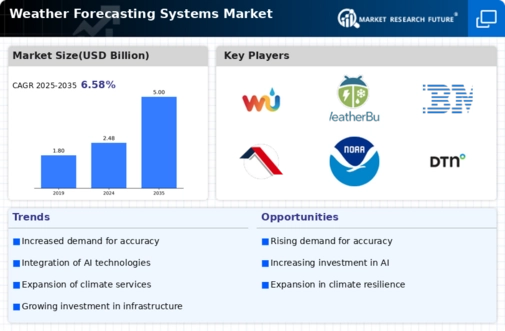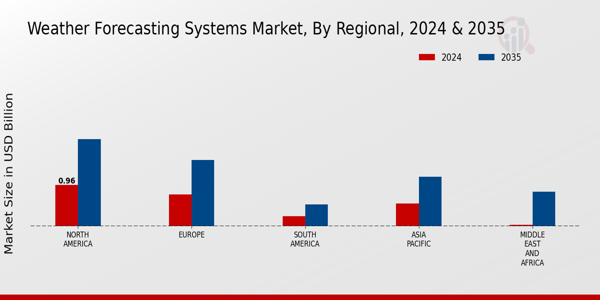Technological Advancements
The Global Weather Forecasting Systems Market Industry is witnessing rapid technological advancements that enhance forecasting accuracy and efficiency. Innovations such as artificial intelligence and machine learning algorithms are being integrated into forecasting models, allowing for more precise predictions. For instance, the implementation of AI-driven models has shown to improve short-term weather predictions by up to 30 percent. As these technologies evolve, they are expected to significantly contribute to the market's growth, with projections indicating a market value of 2.48 USD Billion in 2024. This trend suggests that continuous investment in technology will be crucial for maintaining competitive advantages in the industry.
Integration of Big Data Analytics
The integration of big data analytics into the Global Weather Forecasting Systems Market Industry is transforming how weather data is processed and utilized. By harnessing vast amounts of meteorological data, organizations can derive actionable insights that enhance forecasting accuracy. This trend is particularly relevant as the volume of data generated from satellites and ground stations continues to increase. Companies are leveraging big data tools to analyze patterns and trends, leading to more informed decision-making. As this integration becomes more prevalent, it is expected to contribute to the overall growth of the market, aligning with the anticipated increase in demand for sophisticated forecasting solutions.
Government Initiatives and Funding
Government initiatives play a pivotal role in shaping the Global Weather Forecasting Systems Market Industry. Various national meteorological services are receiving increased funding to enhance their forecasting capabilities. For instance, the National Oceanic and Atmospheric Administration (NOAA) in the United States has allocated substantial budgets for upgrading weather radar systems and satellite technologies. Such investments are expected to improve the accuracy of weather predictions, thereby fostering public trust and reliance on forecasting services. As governments prioritize disaster preparedness and response, the market is likely to experience sustained growth, aligning with the projected CAGR of 6.58% from 2025 to 2035.
Increasing Demand for Climate Resilience
The Global Weather Forecasting Systems Market Industry is increasingly driven by the demand for climate resilience across various sectors. Governments and organizations are recognizing the importance of accurate weather forecasts in mitigating the impacts of climate change. For example, agricultural sectors are utilizing advanced forecasting systems to optimize crop yields and manage resources effectively. This growing awareness is likely to propel the market towards a projected value of 5 USD Billion by 2035. The emphasis on climate adaptation strategies indicates that stakeholders are prioritizing investments in weather forecasting systems to enhance resilience against extreme weather events.
Growing Awareness of Severe Weather Events
The Global Weather Forecasting Systems Market Industry is significantly influenced by the growing awareness of severe weather events and their potential impacts. Recent trends indicate that communities are increasingly seeking reliable forecasting systems to prepare for natural disasters such as hurricanes, floods, and droughts. The heightened focus on disaster risk reduction is prompting investments in advanced forecasting technologies. For example, regions prone to hurricanes are adopting sophisticated models that provide timely warnings, potentially saving lives and property. This awareness is likely to drive the market's growth trajectory, as stakeholders recognize the value of accurate weather forecasting in safeguarding communities.




















Leave a Comment